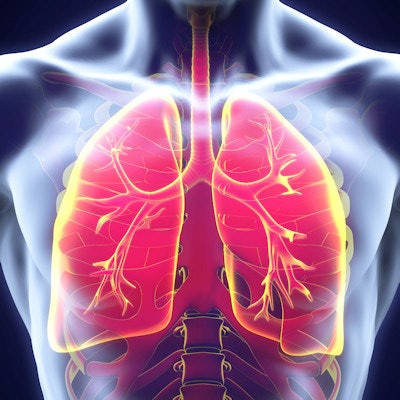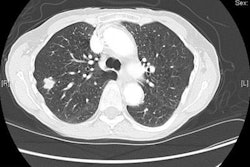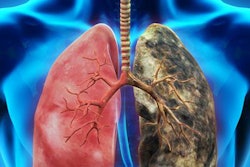
Restricting eligibility for CT lung cancer screening to the heaviest smokers would make the exam more cost-effective on a population basis, according to a study published February 7 in PLOS Medicine.
Investigators from the Netherlands and Canada used a simulation model to analyze 576 different lung cancer screening policies for a group of individuals between 1940 and 1969 in Ontario, Canada. They found that the more exclusive screening criteria were more cost-effective than less demanding requirements (PLOS Medicine, February 7, 2017).
"Overall, policies that applied stringent eligibility criteria, such as requiring more years of heavy smoking to be recommended for screening, were more cost-effective than less stringent eligibility criteria, due to the focus on groups at elevated risk for lung cancer given their smoking history," wrote lead author Kevin ten Haaf in an email to AuntMinnie.com. Also, policies that recommended annual screening were estimated to be more cost-effective than biennial screening, he said.
Ten Haaf is a scientific researcher at University Medical Center Rotterdam in the Netherlands. Participating Canadian institutions included Brock University and the Institute for Clinical Evaluative Sciences, both in Toronto; Alberta Health Services in Alberta; and the Ottawa Hospital Research Institute in Ottawa, Ontario.
Cost-effective in limited studies
Lung cancer screening in the National Lung Screening Trial (NLST) was cost-effective by U.S. standards, yielding estimated cost-effectiveness ratios of $52,000 per life-year gained and $81,000 per quality-adjusted life-year. The NLST used limited microsimulation modeling to arrive at its screening recommendations.
When the U.S. Preventive Services Task Force recommended CT lung screening in 2013, it based its decision on a modeling study that considered trade-offs between the benefits and harms of different screening scenarios "but didn't formally consider their cost-effectiveness," the authors wrote. Other studies have examined screening's cost-effectiveness but yielded inconclusive results. One problem was that many studies reported average cost-effectiveness ratios for all groups, thereby delivering misleading cost estimates.
"These studies considered only limited numbers of screening policies, and provided only limited information on how different screening policy characteristics affect the cost-effectiveness of lung cancer screening," ten Haaf and colleagues wrote.
The current study looked more closely at cost-effectiveness via the microsimulation model, investigating the benefits of screening, such as lung cancer mortality reduction, versus the harms, such as false positives and overdiagnosis, to overcome some of the limitations of previous studies.
MISCAN-Lung
This study used a model called the Microsimulation Screening Analysis (MISCAN-Lung). MISCAN-Lung simulates life histories for each individual in the potential screening population from birth until death in the presence or absence of screening. The model also generates a smoking history and considers the probability of developing lung cancer based on four histological types.
The model assumes the progression of cancer through various disease stages from IA to IV, with opportunities for detection at each stage due to symptoms, after which the patient is treated. Survival depends on the stage at detection, age, and gender. The effects of screening are also derived from disease duration, detectability in screening, and population characteristics.
The analysis included smokers born between 1940 and 1949, 1950 and 1959, and 1960 and 1969 -- groups that represent about 5.2 million individuals of screening age for which low-dose screening is currently recommended, the authors wrote.
"Through comparing the life histories in the presence of screening with the corresponding life histories in the absence of screening, MISCAN-Lung can estimate the effectiveness and costs of screening scenarios," ten Haaf and colleagues explained.
In all, the researchers examined 576 potential screening scenarios, looking at different combinations of age at screening, age to stop screening, screening intervals, eligibility with regard to cumulative exposure, and time (if applicable) since quitting.
Types of cumulative smoking criteria included those modeled on the NLST, those modeled on the Nederlands-Leuvens Longkanker Screenings Onderzoek (NELSON) lung cancer screening trial, and scenarios based on time since quitting smoking. For each screening scenario, the team calculated the number of lung cancer deaths prevented, life-years gained, proportion of individuals screened, number of CT scans, screen-related interventions, false positives, noncancer-related surgeries, overdiagnoses, and costs -- comparing them with no screening.
Stringent criteria more cost-effective
The results showed that stringent eligibility criteria, such as requiring more years of heavy smoking to qualify for screening, was more cost-effective than less stringent eligibility criteria.
For example, the most cost-effective scenario for annual low-dose CT screening was age 55 to 75 years, smoking history of more than 40 pack-years, and quitting, if applicable, fewer than 10 years ago. The cost was about $33,800 per life-year gained versus $52,000 for the NLST, which required a smoking history of only 30 pack-years for participation.
"Lung cancer screening can be cost-effective in a population-based setting when eligibility is restricted to high-risk groups," the authors wrote. "In contrast, utilizing loose eligibility criteria yields nonoptimal and potentially cost-ineffective scenarios ... primarily the smoking eligibility criteria."
The results suggest that "greater reduction in lung cancer mortality and number of life-years gained by annual screening outweigh the costs of the additional number of CT examinations compared with biennial screening, which has previously been suggested to be equally or more cost-effective than annual screening," the authors wrote. Unfortunately, previous studies also show that lung cancer may be more difficult to detect in stage IA with biennial screening.
Also, "as survival in stage IA is considerably higher compared with other stages, the potential for mortality reduction and life-years gained is higher for annual screening compared to biennial screening," they wrote.
Scenarios with older starting ages had lower costs than scenarios that started at younger ages, but they also yielded a smaller number of life-years gained, according to ten Haaf and colleagues. Scenarios with eligibility criteria that required fewer pack-years of smoking history (20 or more) were outperformed by scenarios that required higher numbers of pack-years.
The optimal scenario is estimated to catch fewer cancers than the criteria used in the NLST, but the study predicts that the stricter screening criteria would require fewer CT scans, reduce costs, lead to fewer false-positive screens, and deliver less overdiagnosis, which can harm patients.
Limitations included a lack of quality-of-life measures. In addition, follow-up procedures were based on NLST data, while screening practice has evolved since then to incorporate algorithms with lower false-positive rates. By reducing false-positives, the number of unnecessary follow-up CTs and invasive diagnostic procedures may also fall, further improving the cost-effectiveness of lung cancer screening, the authors wrote.
This study goes beyond previous work by considering an extensive number of screening policy scenarios, yielding more insight into the effects of policy characteristics, compared with evaluating just a few scenarios, ten Haaf told AuntMinnie.com.
For future work, it would be interesting to assess the cost-effectiveness of other lung cancer risk-prediction models, which show great promise for selecting individuals for lung cancer screening, ten Haaf said.
"Furthermore, recent studies indicate that the results of previous screening examinations provide additional information on an individual's risk for developing lung cancer in the future," he added. "It would be valuable to evaluate whether this information can be used to personalize the interval between screenings and what impact this has on cost-effectiveness."



















